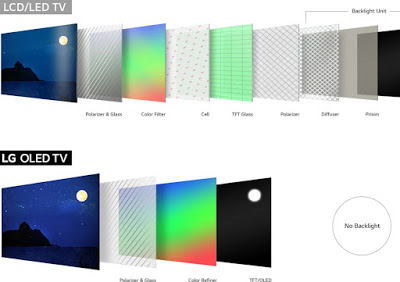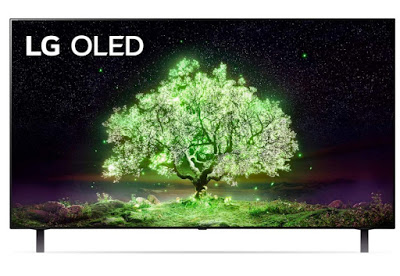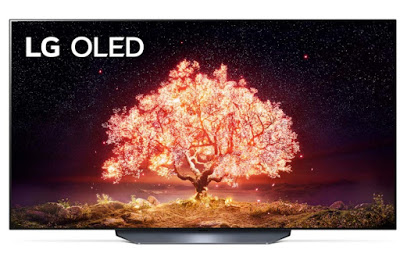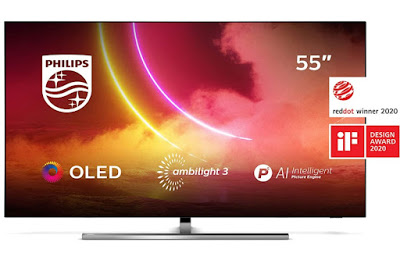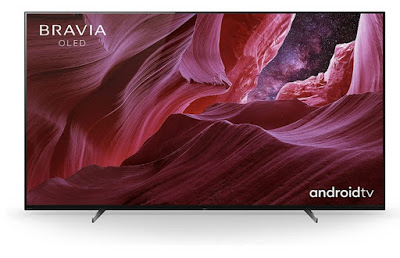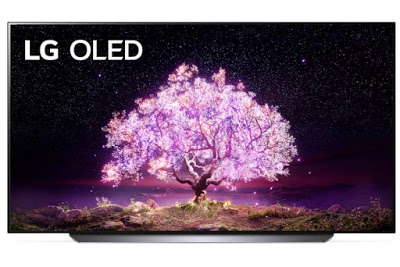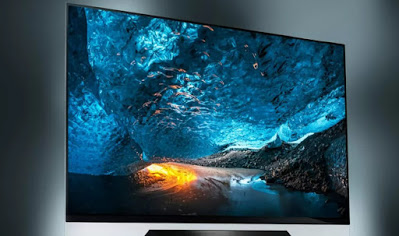 Visiting a shopping mall or an electronics store we will increasingly find very large televisions equipped with OLED technology. Few people really know the meaning of this acronym and, even if the televisions look very beautiful and spectacular in the store, it is not certain that this spectacularity can be replicated in every home or in every living room, since even OLED TVs also have some defects to be taken into account.In the following guide we will show you what is an OLED TV and what are the differences with LED TV models, what are the disadvantages of this technology and which OLED TVs should be taken online on a site like Amazon, the only one that offers complete after-sales assistance and a product guarantee, with reimbursement of expenses within two years of purchase.
Visiting a shopping mall or an electronics store we will increasingly find very large televisions equipped with OLED technology. Few people really know the meaning of this acronym and, even if the televisions look very beautiful and spectacular in the store, it is not certain that this spectacularity can be replicated in every home or in every living room, since even OLED TVs also have some defects to be taken into account.In the following guide we will show you what is an OLED TV and what are the differences with LED TV models, what are the disadvantages of this technology and which OLED TVs should be taken online on a site like Amazon, the only one that offers complete after-sales assistance and a product guarantee, with reimbursement of expenses within two years of purchase.READ ALSO -> OLED or QLED: what is the best technology for new TVs?
What does OLED TV stand for
With OLED we identify screen technology based on Organic LED: every single pixel on the screen is illuminated by a Organic microscopic LED, which turns off and on according to what is transmitted on the screen, also changing color according to the type of image (RGB colors).
The OLED panel therefore provides both the brightness and the detail and colors of the transmitted image, thus marking a profound difference with the traditional LCD technology, on which the liquid crystals were illuminated by a dedicated backlight panel (which on modern TVs are composed of an outline of LEDs, or EDGE LEDs).
This technology has not yet taken hold on all TVs on the market because producing these panels is extremely expensive, relegating them for the moment only to the high-end and premium TV market. In the future the price will certainly go down, but for now they are still quite a niche product.
Pros and cons of an OLED TV
The advantages of an OLED TV are easy to understand, especially if we have grasped the differences with respect to the traditional LCD panel:
- High viewing angle: the viewing angle remains perfect even when looking at the TV from the side, without smudging or loss of detail.
- Perfect black and infinite contrast: Since OLEDs can be turned off completely to create black, black images are perfect and the contrast with whites is truly infinite, making images one of a kind.
- Energy efficiency: OLED TVs consume very little energy, especially when compared to LCD TVs of the same diameter. The OLEDs turn off when needed and the brightness is never too high, thus making these TVs really efficient.
- Minimum response times: these new TVs have a very short response time (around 0.2ms, compared to 3.5ms for traditional TVs), making them the ideal TVs for those who play consoles or for those who want to connect a gaming PC.
- Very thin TVs: since many of the traditional LCD panels are missing, the thickness of the OLED TVs also benefits, with thicknesses in the order of 3mm or less. These TVs are therefore very thin, beautiful to look at and to hang like pictures.
Even if the merits can be very convincing, it is still worth taking a look at what they are the flaws of OLED TVs:
- Low brightness: Organic LEDs don’t emit a lot of light, thus putting TVs in trouble when viewed in brightly lit environments or with a window nearby. It is advisable to always use them at night, limiting their use to the maximum during the day.
- Burn-in risk: OLED TVs are at very high burn-in risk, although operators work a lot to reduce this problem of all TVs (it also affects LCDs). The burn-in effect occurs when a static image or a color remains fixed on the screen for more than a few seconds, leaving a sort of trail or halo clearly visible against the light or if an all-black or white background is immediately reproduced.
- High price: producing OLED panels is very expensive, especially on the diagonals with which these TVs are offered (from 50 inches upwards). Consequently, OLED TVs also come with a very high price compared to the competition, but which is slowly falling over the last few years: today we can take home an OLED even for less than 1500 €, unthinkable until 2-3 years ago. .
We therefore carefully evaluate the defects and choose whether to spend a lot for a TV that still has defects and therefore needs more attention and care during use, especially to reduce the burn-in effect (really very bad and difficult to solve. once it starts showing up).
Best OLED TVs of the moment
After seeing what are the characteristics of an OLED TV, let’s see together which are the best TVs to buy online on Amazon. The first TV we can see is LG OLED48A16LA Smart TV 4K 48 “, sold and shipped by Amazon for less than 1000 €.
This TV has a 48-inch OLED screen, α7 Gen4 processor, Dolby Vision IQ system, Wi-Fi connection, webOS 6.0 operating system, FILMMAKER MODE, Game Optimizer mode, voice control with integrated Google Assistant and Alexa and remote control system. Pointer.
Among the best TVs over 50 inches we certainly find the LG OLED55B16LA Smart TV 4K 55 “, sold and shipped by Amazon for less than 1200 €.
On this TV we find a 55-inch OLED screen, α7 Gen4 processor, Dolby Vision IQ system, Wi-Fi connection, webOS 6.0 operating system, FILMMAKER MODE, support for Google Assistant and Alexa Integrated, 2 HDMI 2.1 ports and Pointer Remote .
If we are looking for something other than LG TVs we can take a look at the Philips TV Ambilight 55OLED855/12 55″, sold and shipped by Amazon for less than 1300 €.
On this TV we find a 55-inch OLED screen, P5 AI Picture Processor, HDR10 + support, Dolby Vision audio system, Atmos technology support, Android TV operating system and Alexa voice commands support.
In the high-end of OLED TVs we can definitely find the Sony Bravia OLED KE-55A8P, sold and shipped by Amazon for less than 1400 €.
This TV boasts a 55-inch OLED screen, ULTIMATE X1 processor, 4K ULTRA HD resolution, Pixel Contrast Booster system, ACOUSTIC SURFACE AUDIO sound system, Android TV operating system and support for Google Assistant voice commands.
As top of the range for the OLED TV category we can see the LG OLED65C14LB Smart TV 4K 65 “, sold and shipped by Amazon for less than 2300 €.
This TV boasts a 65-inch OLED-type screen, 4K UHD resolution, HDR support, α9 Gen4 processor, Dolby Vision IQ system, Wi-Fi connection, webOS 6.0 operating system, FILMMAKER MODE, integrated Google Assistant and Alexa support, 4 HDMI 2.1 ports and Remote Control Pointer.
Conclusions
The main producer of OLED is LG, which also supplies its panels to Philips and Sony: if we are looking for a good OLED TV, let’s make sure it is one of the producers mentioned, since all the others have decided to focus on LCD technology again (also if evolved). To buy an OLED TV we need to spend at least € 1000 and we must have the space to accommodate a TV of at least 48 inches.
To learn more we can read our guides How far to view TV or monitor based on screen size and Differences between LCD, LED and Plasma TVs to understand which TV to buy.

